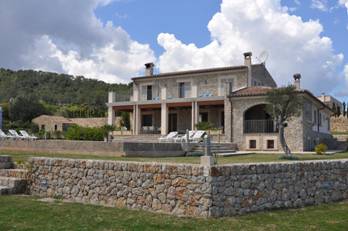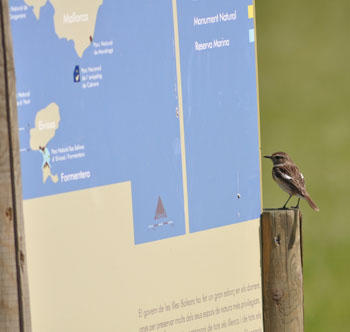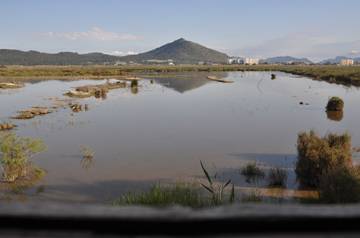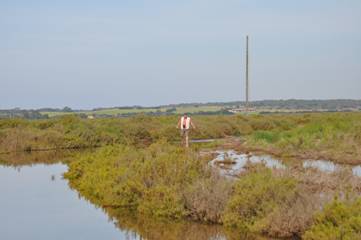GETTING THERE
 Again, as in previous years, we chose Villa Select to provide both our accommodation and our flight. Our choice this year was the beautiful Villa Casesnovas. The villa is situated within the triangle of Pollensa, Puerto Pollensa and Alcudia. A little further out than any of our previous villas, but it did mean we were within a 10min drive of the premier birding site “Albufera”.
Again, as in previous years, we chose Villa Select to provide both our accommodation and our flight. Our choice this year was the beautiful Villa Casesnovas. The villa is situated within the triangle of Pollensa, Puerto Pollensa and Alcudia. A little further out than any of our previous villas, but it did mean we were within a 10min drive of the premier birding site “Albufera”.
Our carrier was Monarch Airlines. Both outward and inward flights were bang on time with both planes approximately 75% full. The flight out was 06:20 am, possibly a little early for some, but great when you are sipping your first cold drink at your destination by lunch time. Return flight was mid morning giving us the luxury of a leisurely breakfast.
For superb self catering accommodation and late availability list I strongly recommend you check out Villa Select’s web site.
Villa Select can be contacted on 0845 277 3370 or by email.
WEATHER
In the main the weather was dry and warm with temperatures in the mid 20s for most of the holiday. Night time temperatures dropped to single figures making early morning birding a bit parky. Rain was restricted to a couple of nights and the Friday morning prior to our departure.
COST OF LIVING
With virtual parity between the Pound & Euro Mallorca ain’t cheap any more, with most food stuff costing at least the same as England. Eating out at night had risen, both in the cost of the meal and the poor exchange rate.
CAR HIRE
As with the cost of living, the price of car hire had also increased, with an equivalent car in England costing at least 25% less.
Fuel however was slightly cheaper with diesel costing approximately 89p per litre.
 These trips to Mallorca have turned into bi-annual events with Lesvos being visited in alternate years. It amazes us how much the island changes over such a short period. New roads, including dual carriageways, have materialised in the Pollensa Bay area. Many are roads to “nowhere”; this indicates that further large scale development of the bay area is on the cards. The main thoroughfare through Alcudia has also been upgraded, with all the traffic lights being replaced with roundabouts, all sporting their own piece of sculpture. Brightly coloured cycle lanes have also been installed. The spine road that runs from south to north has also been upgraded. With a “motorway” & dual carriageway terminating approximately 10k short of Alcudia, making transfer times from the airport to the north of the island comfortably less than 1hr.
These trips to Mallorca have turned into bi-annual events with Lesvos being visited in alternate years. It amazes us how much the island changes over such a short period. New roads, including dual carriageways, have materialised in the Pollensa Bay area. Many are roads to “nowhere”; this indicates that further large scale development of the bay area is on the cards. The main thoroughfare through Alcudia has also been upgraded, with all the traffic lights being replaced with roundabouts, all sporting their own piece of sculpture. Brightly coloured cycle lanes have also been installed. The spine road that runs from south to north has also been upgraded. With a “motorway” & dual carriageway terminating approximately 10k short of Alcudia, making transfer times from the airport to the north of the island comfortably less than 1hr.
With all the development of the infrastructure and the continued building of holiday accommodation, many of the small scrubby areas that used to be so attractive to passing migrants have disappeared. This has greatly reduced the wild flowers & weeds and in turn the insects on which the birds feed. We have noted a steady decline over the last 10 years in the numbers of birds that either nest on Mallorca or stay briefly to fuel up.
Birding sites that once were a must to visit a few years ago are now a shadow of their former selves. It’s not surprising when you see that most of these are the ones that have suffered most from urbanisation. The Boquer Valley is a prime example; birding here has declined to such an extent that it’s best left to the walkers. I could not have imagined myself saying that a few years ago. Other northern sites that have also markedly declined, to such an extent that a cursory visit is all they warrant, are “Casas Veyas” (no access), “Albufereta” (no management), “Back Lanes”, “Smelly River” and “Lenair Road” (lack of areas to park).
 As I have stated in previous reports, the bird species are still there, it’s the numbers that have declined, making the birding challenging at the very least.
As I have stated in previous reports, the bird species are still there, it’s the numbers that have declined, making the birding challenging at the very least.
S’Albufera – On a more positive note, after many years of resources being channelled into the visitor centre, toilet blocks, pretty boardwalks, hides and viewing platforms, all great for the human visitor, it now looks like the park authority is getting to grips with improving the habitat for the birds….and how it shows! With improvements to water level management and the general habitat, bird numbers and species were up considerably.
MOANS, GROANS AND MEMORABLE MOMENTS
Moan
Once again we had problems with Hertz car rentals. Although we had documentation which clearly stated that the price taken over the internet was guaranteed, we still had to spend 15 minutes arguing with the staff, who were quoting 40 € more. We were also charged 8 € a day for a second driver when the web site clearly stated the second driver was free. This added a further 112 € to the bill. We had a similar situation several years ago in Lesvos. On our first venture out in the vehicle we had a puncture. There was no spare tyre, so we had to wait several hours whilst they delivered a replacement. We were charged 120 € for the pleasure when we returned the vehicle. Total cost of the vehicle rose from the 344 € quoted, to 576 €. “Never again Mr Hertz”.
Groan
Those pillocks in Lycra who invade Mallorca in their thousands during the early spring. We believe in “live and let live” but when they decide to ride 3-4 abreast in their hundreds on the road, completely ignoring the lovely new cycle lanes provided, it’s difficult to look benevolently upon them. Meeting several dozen of them, spread right across a very narrow winding lane and gesticulating to me to get over, was the last straw. My outburst of “single file dicken ze headens” was greeted with hysterical laughter from my own passengers. Well you have to laugh!
Memorable moments
 The hospitality shown to us by a Geordie called Malcolm, whose help and hospitality, whilst we were waiting for our exchange vehicle, was very greatly appreciated.
The hospitality shown to us by a Geordie called Malcolm, whose help and hospitality, whilst we were waiting for our exchange vehicle, was very greatly appreciated.
The dozen or so Bee-eaters that decided to hang around the villa for a couple of days giving great views.
Local Stone Curlews being called up, to give great illuminated views as they flew over the villa at night.
Not sticking to our own rule of not venturing down to the Salinas de Levante until we have had at least 3 dry days. Then, finding on our arrival, that “Eddie’s Track” was hock deep in mosquito infested water.
Embarking on what we thought would be an hour’s walk through the Albufera. We finally reached the visitor centre 6hrs later. Incidentally this also occurred on the hottest day of the holiday at 28°c.
SITES VISITED
Albufera, Albufereta, Casas Veyas, Boquer Valley, Cuber Reservoir, Son Serra de Marina, Son Marc, Depuradora, Postage Stamp Wood, Cala de San Vicenç, S’Illot and Salinas de Levante.
Bird Species List
- Great Crested Grebe Podiceps cristatus Only sighting was a pair displaying on the Grand Canal Albufera.
- Little Grebe Tachybaptus ruficollis Small numbers of birds, main sites being the Albufera, Albufereta and San Serra de Marina.
- Shag Phalacrocarax aristotalis Odd birds seen on the breakwaters at Puerto Pollensa first week.
- Night Heron Nycticorax nycticorax Numbers at the Albufera roost appeared to be down, with no more than a dozen birds encountered during our visits. More than 20 birds seemed to be the norm in 2005.
- Squacco Heron Ardeola rallioides More birds were encountered during this trip than any previously with up to 6 birds seen together.
- Cattle Egret Bubulcus ibis Now the most common of the egrets on the Island with several hundred seen in the roost near the entrance to the Albufera.
- Little Egret Egretta garzetta Although not now as common as the former, still good numbers were seen most days in suitable habitats.
- Great White Egret Egretta alba Only 1 sighting, a bird flying with a Little Egret at the back of the Albufera.
- Grey Heron Ardea cinerea Birds were very common at all suitable habitats.
- Purple Heron Ardea purpurea A good year for this species with 5 birds seen flying low over the Albufereta.
- Sacred Ibis Threskiornis aethiopicus Never 100% sure of the status of these birds. They have been at the Albufera for many years. 3 sightings of a single mature bird in flight.
- Greater Flamingo Phoenicopterus ruber Just 7 adult birds seen at the Salinas de Levante. Up-to 50> have been encountered at the same site in autumn.
- Shelduck Tadorna tadorna From only 2 sightings in Oct 2005 to many dozens of breeding pairs at the Albufera, Depuradora, Albufereta and the Salinas de Levante.
- Gadwall Anas strepera A common duck with small numbers seen at suitable locations.
- Teal Anas crecca Numbers down this spring with 1 female the only sighting.
- Mallard Anas platyrhynchos Extremely common at all suitable habitats.
- Shoveler Anas clypeata Small numbers, mainly at the Depuradora.
- Red-crested Pochard Netta rufina Another success story with more birds being encountered year on year.
- Pochard Aythya farina 3 sightings of up to 2 males at the Depuradora.
- Tufted Duck Aythya fuligula Just a single sighting of a male on the Grand Canal at the Albufera.
- Griffon Vulture Gyps fulvus 1 bird seen at the Son Marc Valley during our first visit.
- Black Vulture Aegypius monachus Only sighting was six individuals during the trip to Cuber reservoir.
- Marsh Harrier Circus aeruginosus A very common raptor, with six seen in the air at the same time over the Albufera.
- Montagu’s Harrier Circus pygargus A fly past at the villa by a male at the end of the first week.
- Golden Eagle Aquila chrysaetos A single sub-adult bird caused confusion with a low fly-over at the Albufera.
- Bonelli’s Eagle Hieraaetus fasciatus A low fly-by over the villa during the first week.
- Booted EagleHieraaetus pennatus Odd birds seen, but again numbers appeared to be down on previous visits.
- Osprey Pandion haliaetus Several encounters during the trip, with 1 bird successfully catching a large fish at the Albufereta and another bird tucking into a fish on the traditional roosting post at “Orange Bridge”.
- Kestrel Falco tinnunculus Common over the whole island.
- Eleonora’s Falcon Falco eleonorae Birds not seen until late in the second week of the trip & then in very small numbers.
- Red-legged Partridge Alectoris rufa Several sightings with a resident pair in the fields below the villa.
- Moorhen Gallinula chloropus Birds in small numbers at all suitable locations.
- Purple Gallinule Porphyrio porphyrio All sightings confined to the Albufera this trip. Since their introduction these birds have spread right across the north of the island taking up residence at all suitable locations.
- Coot Fulica atra Birds abundant at all suitable habitats.
- Red-knobbed Coot Fulica cristata Reintroduced a few years ago, these birds have now achieved full breeding status. Birds are now common at the Albufera. Some introduced birds still contain white neck rings. These were used to separate the species during the winter, when hunting is permissible.
- Stone Curlew Burhinus oedicnemus A very good year with many sightings throughout the trip. A pair was very vocal at night in the fields adjacent to the villa.
- Collared Pratincole Glareola pratincola Several birds seen at the Albufera early in the first week.
- Avocet Recurvirostra avosetta 50> at the Salinas de Levante.
- Black-winged Stilt Himantopus himantopus Very common breeding wader.
- Little Ringed Plover Charadrius dubius Common at suitable sites.
- Ringed Plover Charadrius hiaticula More birds encountered in the north of the island than previously. Probable cause is the habitat management taking place on the Albufera.
- Kentish Plover Charadrius alexandrinus Very common this trip, again the habitat management may account for the increase.
- Grey Plover Pluvialis squatarola A singleton at the Salinas de Levante the only sighting.
- Knot Calidris canutus A single male at the Albufera and our first for the Island.
- Little Stint Calidris minuta More birds in the north of the Island than previous years. Habitat improvements and water level management, probable cause.
- Temminck’s Stint Calidris temminckii Small numbers during first week of the trip. All sightings at the Albufera.
- Curlew Sandpiper Calidris ferruginea Far more birds encountered; probable cause the same as the stints.
- Dunlin Calidris alpina A single sighting for the trip at the Albufera.
- Ruff Philomachus pugnax Odd birds seen, all sightings confined to the back of the Albufera reserve.
- Snipe Gallinago gallinago Small numbers seen during most visits to the Albufera.
- Spotted Redshank Tringa erythropus Up to 5 birds seen at Bishops (1) hide during the first week.
- Redshank Tringa totanus Small numbers; more numerous in the south.
- Greenshank Tringa nebularia One of the few wader species where the numbers were down on previous years. Most sightings at the Albufereta.
- Green Sandpiper Tringa ochropus Only a couple of sightings, both during the first week and both at the Depuradora.
- Wood Sandpiper Tringa glareola Another species which has benefited from both habitat and water level management with many more birds than in previous springs.
- Common Sandpiper Actitis hypoleucos Numbers clearly up on previous years.
- Turnstone Arenaria interpres A singleton at the Albufera at the end of the 2nd week.
- Black-headed Gull Larus ridibundus A small number of birds seen loafing on the rocks in the corner of the lagoon viewed from “Orange Bridge”.
- Audouin’s Gull Larus audouinii Fewer gulls obvious than in previous visits.
- Yellow-legged Gull Larus cachinnans Abundant.
- Common Tern Sterna hirundo 3 pairs at the Albufera which will hopefully breed on the newly created tern islands.
- Whiskered Tern Chlidonias hybridus 5 birds hawking over the Depuradora at the beginning of the first week, with a singleton during the second.
- Stock Dove Columba oenas A couple of sightings of single birds, with 4 seen flying over the Albufera during the second week.
- Wood Pigeon Columba palumbus Common at all suitable locations.
- Swift Apus apus A strong daily migration with many thousands passing through, especially during the second week.
- Pallid Swift Apus pallidus Dozens of birds over the Albufera early in the first week.
- Collared Dove Streptopelia decaocto Numbers appear to have stabilised with birds encountered most days.
- European Bee-eater Merops Apiaster Many birds passing through the island during the second week.
- Hoopoe Upupa epops Birds numbers appear to have declined. No birds were seen at the Depuradora where previously a flock of 6 birds were in residence.
- Sand Martin Riparia riparia Just a handful of birds seen early doors.
- Crag Martin Ptyonoprogne rupestris Sightings were down this year with a few birds at the Boquer Valley and several around the dam at Cuber Reservoir. Best sighting was a dozen or so flying around Palma airport terminal.
- Swallow Hirundo rustica Strong passage during the whole trip with numbers increasing daily.
- House Martin Delichon urbica Only birds seen were odd birds with migrating swallows and swifts.
- Thekla Lark Galerida theklae A couple of birds encountered at the most reliable site, Son Serra de Marina. As this site is so reliable I no longer venture far to find them.
- Meadow Pipit Anthus pratenis A single bird in the Son Marc Valley.
- Tawny Pipit Anthus campestris A single bird display flying at Cuber.
- Yellow Wagtail Motacilla flava Many sighting of the nominate race, with good numbers of feldegg also observed.
- Wren Troglodytes troglodytes A singleton at Cuber.
- Nightingale Luscinia megarhynchos A very good year for this species with birds singing at all suitable locations.
- Redstart Phoenicurus phoenicurus A male and female seen at different locations in the Son Marc valley and a female feeding on the lawn of the villa.
- Stonechat Saxicola torquata Very common at all suitable locations.
- Northern Wheatear Oenanthe oenanthe 1 male seen at the Salinas de Levante.
- Blue Rock Thrush Monticola solitarius Birds at all usual haunts.
- Blackbird Turdus merula Birds common at all suitable sites.
- Cetti’s Warbler Cettia cetti Very, very common at all suitable locations.
- Fan-tailed Warbler Cisticola juncidis Birds seen at most suitable locations.
- Great Reed Warbler Acrocephalus arundinaceus Numbers of these birds appear to have tumbled over the years with less than half a dozen pairs encountered over the whole of the Albufera.
- Balearic Warbler Sylvia balearica Several birds reported at the Boquer valley but our only sighting was at the traditional site at Cala Sant Vicenç.
- Sardinian Warbler Sylvia melanocephala The commonest of all the warblers with several territories around the villa.
- Blackcap Sylvia atricapilla Only sightings were during our 2 visits to the Son Marc Valley.
- Wood Warbler Phylloscopus sibilatrix 2 encounters, 1 at the pines near the Boquer and the 2nd at Cuber.
- Chiffchaff Phylloscopus collybita Just a couple of sightings during the trip at suitable sites.
- Willow Warbler Phylloscopus trochilus Again a couple of birds seen during the trip.
- Firecrest Regulus ignicapillus Sightings at the traditional site at Casas Veyas.
- Spotted Flycatcher Muscicapa striata Very common, with the Son Marc valley literally dripping with them.
- Pied Flycatcher Ficedula hypoleuca A single male hawking for insects in the Son Marc valley.
- Great Tit Parus major Small numbers of birds seen at most suitable sites.
- Golden Oriole Oriolus oriolus A single bird flew through the villa garden at the beginning of the second week.
- Woodchat Shrike Lanius senator A common bird; all suitable locations appear to have birds in residence.
- Raven Corvus corax Odd birds at the Boquer valley and a few in Son Marc.
- House Sparrow Passer domesticus Birds common everywhere.
- Chaffinch Fringilla coelebs Common at all suitable habitats.
- Serin Serinus serinus Small flocks, especially where conifers occur.
- Greenfinch Carduelis chloris Abundant.
- Goldfinch Carduelis carduelis The second commonest finch of the summer.
- Linnet Carduelis cannabina Birds not uncommon.
- Crossbill Loxia curvirostra Any large area of conifers will contain Crossbills. The Formentor peninsula holds a very large population.
- Cirl Bunting Emberiza cirlus Although not prolific, both Son Marc & the Campanet valley hold good populations.
- Reed Bunting Emberiza schoeniclus A single sighting of a male at the Albufera.
- Corn Bunting Miliaria calandra From being a common bird some 10 years ago, a steady decline has taken place with only 2 sightings throughout the trip.
- Waxbill Estrilda astrild A singleton at the back of the Albufera was the only sighting this trip.
Pat and Judy Hayes
